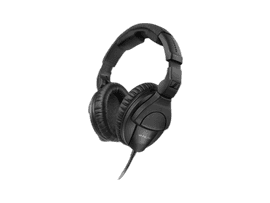When it comes to headphones that have stood the test of time, the Sennheiser HD25 is a name that frequently comes up. With a legacy spanning over three decades, these headphones have been the go-to choice for DJs, sound engineers, and audiophiles alike. But how do they fare as a pair of headphones for studying or working? Let's dive into the details.
Sound Quality
The Sennheiser HD25 is renowned for its exceptional sound quality. These headphones offer a neutral sound profile, which makes them ideal for a variety of uses, from music production to casual listening. The high sensitivity due to lightweight aluminum voice coils ensures that the sound is crisp and clear, capable of handling very high sound pressure levels without distortion.
Pros:
- Neutral Sound Profile: Perfect for those who prefer a balanced sound without exaggerated bass or treble.
- High Sensitivity: The lightweight aluminum voice coils contribute to a clear and detailed sound.
- Dynamic Drivers: These ensure a wide frequency response, capturing every nuance of your audio.
Cons:
- Not Bass-Heavy: If you're a bass enthusiast, you might find the HD25 lacking in this department.
- Requires Break-In: Some users have noted that the sound quality improves after a few weeks of use.
Comfort
Comfort is a critical factor, especially if you plan to wear these headphones for extended periods while studying or working. The HD25 is designed to be lightweight, weighing in at just 4.9 ounces. The on-ear design, however, can be a double-edged sword.
Pros:
- Lightweight: At 4.9 ounces, these headphones are incredibly light, reducing fatigue during long sessions.
- Replaceable Parts: The ear cups and headband padding are replaceable, ensuring long-term comfort.
- Break-In Period: Initially tight, the foam padding softens over time, making them more comfortable.
Cons:
- On-Ear Design: This can become uncomfortable after prolonged use, especially if you have larger ears.
- Initial Tightness: The headphones are tight out of the box, which can be uncomfortable until the foam breaks in.
Noise Cancellation
One area where the Sennheiser HD25 falls short is noise cancellation. These headphones do not offer active noise cancellation, relying instead on passive noise isolation. While this is sufficient for many environments, it may not be ideal for very noisy settings.
Pros:
- Passive Noise Isolation: The tight fit and closed-back design provide decent noise isolation.
- No Battery Required: Since there's no active noise cancellation, you don't have to worry about battery life.
Cons:
- No Active Noise Cancellation: This can be a deal-breaker for those who need to block out significant background noise.
- Limited Isolation: Passive isolation is not as effective as active noise cancellation, especially in very noisy environments.
Battery Life
The HD25 does not require a battery, which is a significant advantage for those who dislike the hassle of charging their headphones. This makes them a reliable choice for long study or work sessions.
Pros:
- No Battery Needed: You don't have to worry about running out of battery during crucial moments.
- Consistent Performance: The sound quality remains consistent without the degradation that can occur with battery-powered headphones.
Cons:
- No Wireless Option: The lack of a battery also means no Bluetooth connectivity, which could be a downside for some users.
Connectivity
The Sennheiser HD25 features a detachable, single-sided cable with a 3.5mm jack, making it compatible with a wide range of devices. This is particularly useful for those who switch between different audio sources.
Pros:
- Detachable Cable: Easy to replace if damaged, extending the lifespan of the headphones.
- 3.5mm Jack: Universally compatible with most devices.
- Additional Accessories: The HD25 Plus version includes extra cables and a pouch for added convenience.
Cons:
- No Bluetooth: The lack of wireless connectivity can be a limitation for some users.
- Limited Controls: Basic volume control is available, but more advanced features are missing.
Price
At $148.99, the Sennheiser HD25 offers excellent value for money, especially considering its durability and sound quality. While there are cheaper options available, few can match the HD25's performance and longevity.
Pros:
- Affordable: Given the quality and durability, the price is very reasonable.
- Long-Term Investment: The replaceable parts make these headphones a long-term investment.
Cons:
- Initial Cost: While affordable, the initial cost may still be a barrier for some.
- Additional Accessories: The HD25 Plus version, which includes extra accessories, is more expensive.
Durability
One of the standout features of the Sennheiser HD25 is its durability. Many users have reported using these headphones for over a decade with minimal issues. The replaceable parts, including the ear cups and cables, contribute to their longevity.
Pros:
- Built to Last: Designed to withstand heavy use, making them ideal for professionals.
- Replaceable Parts: Easy to maintain and repair, extending their lifespan.
- Robust Design: The materials used are of high quality, ensuring durability.
Cons:
- Plastic Build: While durable, the plastic build may not feel as premium as metal alternatives.
- Wear and Tear: Some users have reported issues with the spring rails and ear cups over time, but these are easily replaceable.
Conclusion
The Sennheiser HD25 is a versatile and durable pair of headphones that excels in sound quality and comfort, making them an excellent choice for studying or working. While they lack advanced features like active noise cancellation and Bluetooth connectivity, their robust build and replaceable parts make them a long-term investment. If you're looking for a reliable pair of headphones that offer exceptional sound quality and durability, the Sennheiser HD25 is hard to beat.
Final Verdict: 4.6/5
With a legacy of reliability and performance, the Sennheiser HD25 is a true "buy it for life" product. Whether you're a student, a professional, or a casual listener, these headphones are a worthy addition to your audio arsenal.




